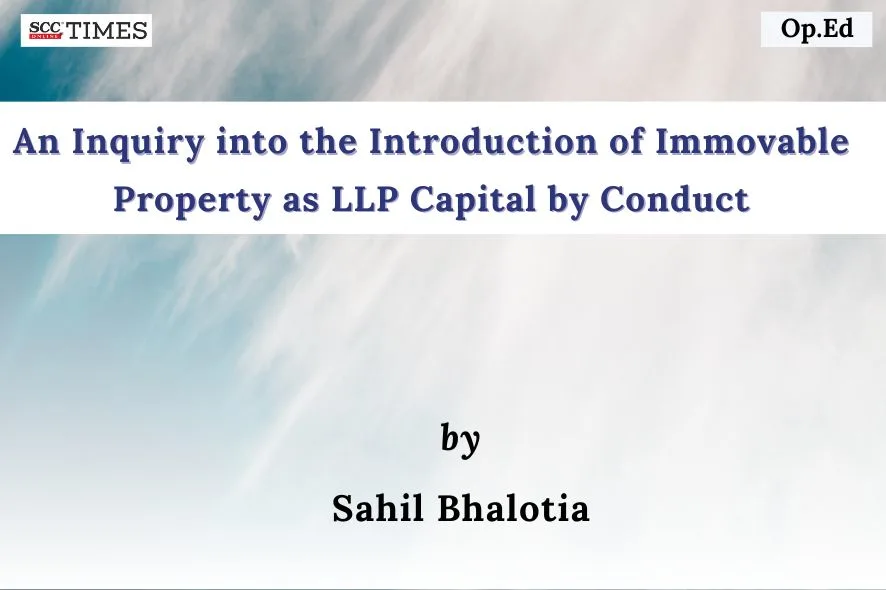The confluence of partnership principles and property law presents a compelling legal situation: can a partner’s immovable property be vested in a limited liability partnership (LLP) as a capital contribution without the execution of a formal registered instrument? This article delves into this intricate question, examining the legal framework that permits such a transfer “by conduct”. It navigates the statutory outlook of the Limited Liability Partnership Act, 20081, and the Partnership Act, 19322, juxtaposing foundational judicial precedents with the stringent mandates of fiscal statutes. The analysis seeks to illuminate the doctrine that privileges intent over instrument in this context, while simultaneously exposing the latent fiscal liabilities that emerge, particularly under the Income-tax Act, 19613. The result is a nuanced exploration of a legally permissible yet perilous corporate practice.
The legal foundation for capital infusion
The statutory authority for a partner to infuse immovable property into an LLP is rooted in the enabling provisions of the Limited Liability Partnership Act, 2008. Section 32(1)4 of the Limited Liability Partnership Act, 2008 gives the definition of a partner’s contribution, explicitly sanctioning contributions of tangible, movable or immovable or intangible property. This provision establishes the foundational possibility of using real estate as a capital base for the LLP.
Once contributed, the character and ownership of such property are governed by well-settled principles of partnership law, primarily encapsulated in Section 145 of the Partnership Act, 1932. This section describes the “property of the firm”, stating that, subject to a contract to the contrary, it includes all assets originally brought into the firm’s common stock. Consequently, upon its introduction as capital, the property sheds its identity as the partner’s separate asset. The partner’s absolute title is transmuted into a shared interest in the collective assets of the partnership. Any individual claim is thereby extinguished, replaced by a right to a distributive share of profits and, upon dissolution, a share in the firm’s surplus assets.
The doctrine of contribution by conduct
The central theory of this inquiry rests on whether this transmutation of ownership necessitates a formal conveyance. Ordinarily, the Transfer of Property Act, 18826, and the Registration Act, 19087, mandate a registered deed for any transfer of interest in immovable property exceeding a nominal value. However, jurisprudence has carved out a significant exception in the realm of partnership law.
This jurisprudential standpoint finds its genesis in the seminal ruling of the Calcutta High Court in Prem Raj Brahmin v. Bhani Ram Brahmin8. The Division Bench elucidated a principle of profound practical importance: for the purpose of integrating a partner’s separate property into the firm’s stock, recourse to a written document is not a prerequisite. The determinative factors are the partner’s unambiguous intention that the asset becomes partnership property and the subsequent treatment of that asset as such by the firm. Where such intention and conduct are evident — typically through entries in the firm’s books of accounts — the property is deemed to belong to the firm by virtue of partnership law, notwithstanding the absence of a formal transfer deed.
Characterisation of title and the inapplicability of the Registration Act, 1908
The mechanism of contribution by conduct raises a crucial question regarding title, especially when the registered title remains in the name of the individual partner. Legally, the LLP acquires beneficial ownership, while the partner retains only the ostensible or legal title, holding the property in a fiduciary capacity for the benefit of the firm.
The Supreme Court of India offered clarity on this matter in its landmark decision in Addanki Narayanappa v. Bhaskara Krishtappa9. The Supreme Court held that the act of bringing immovable property into a partnership’s common stock does not constitute a conveyance, sale, or exchange that would trigger the compulsory registration requirements of Section 1710 of the Registration Act, 1908.
The Court’s reasoning was anchored in its characterisation of a partner’s interest. It affirmed that a partner does not have a specific claim on any single partnership asset but rather holds an interest in the net surplus of the partnership’s assets after the settlement of all its debts and liabilities. Crucially, this interest is judicially construed as movable property, regardless of whether the firm’s underlying assets consist of immovable property. This principle, also affirmed in Ratan Lal Sharma v. Purshottam Harit11, effectively removes the transaction from the ambit of statutes governing the transfer of real estate, thereby obviating the need for registration at the point of contribution.
The fiscal repercussion
While the doctrine of contribution by conduct offers the allure of circumventing immediate registration costs and stamp duty, it harbours a significant fiscal trap that often manifests upon the reconstitution of the firm.
The primary area of concern lies within the Income-tax Act, 1961. Section 45(4)12 of the Income-tax Act, 1961 addresses the taxation of capital gains arising from the transfer of capital assets in connection with the dissolution of a firm or “otherwise”. The judiciary has interpreted the term “otherwise” to include events such as the retirement of a partner.
The decision of the Karnataka High Court in CIT v. Gurunath Talkies13 is particularly instructive. The Court held that where a partner who contributed immovable property retires from the firm, leaving the asset with the continuing partners, the event is tantamount to a “transfer” for the purposes of Section 45(4). This triggers a taxable event, and the firm becomes liable for capital gains tax on the appreciation in the asset’s value (i.e. the difference between its fair market value on the date of retirement and its value in the books). This interpretation, which finds resonance in tribunal-level decisions like Sudhakar M. Shetty v. CIT14, presents a formidable challenge to the perceived tax efficiency of this method.
Concluding perspective
In summation, Indian law validates the introduction of immovable property as capital to an LLP by the sheer conduct and manifest intent of the parties, obviating the need for a registered conveyance. This pathway offers notable upfront advantages in cost and procedural simplicity. The legal fiction that a partner’s interest is movable property, as established by the Supreme Court, provides a robust shield against the application of the Registration Act, 1908 at the inception.
However, this convenience is counterbalanced by a significant, deferred risk. The prevailing interpretation of tax law means that the fiscal liability is not extinguished but merely postponed. The reconstitution of the firm, particularly the retirement of the contributing partner, is likely to be construed as a taxable transfer, potentially crystallising a substantial capital gains liability for the LLP.
Therefore, while contribution by conduct remains a viable legal strategy, it demands meticulous foresight and navigation. The LLP agreement and accounting records must provide unimpeachable evidence of the contribution. Furthermore, partners must weigh the immediate savings against the contingent tax liabilities. This complex interplay of corporate, property, and tax law necessitates sophisticated legal and financial counsel to ensure that a strategy designed for convenience does not ultimately culminate in unforeseen fiscal detriment.
*5th year student, 10th semester, Department of Law, University of Calcutta. Author can be reached at: bhalotiasahil@gmail.com.
1. Limited Liability Partnership Act, 2008.
4. Limited Liability Partnership Act, 2008, S. 32(1).
5. Partnership Act, 1932, S. 14.
6. Transfer of Property Act, 1882.
10. Registration Act, 1908, S. 17.
12. Income-tax Act, 1961, S. 45(4).



